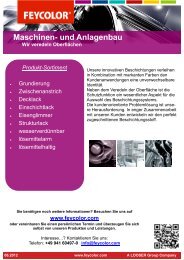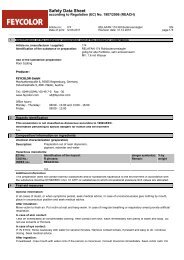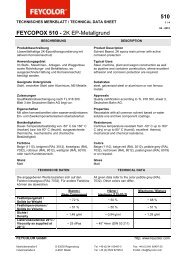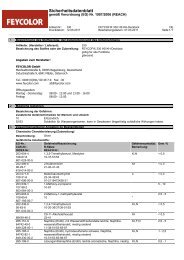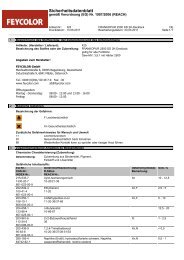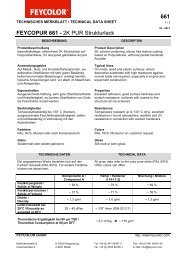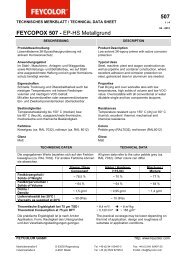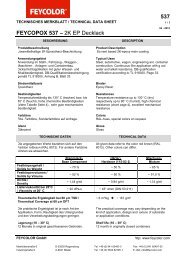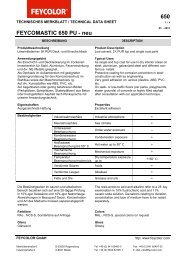Safety Data Sheet - Feycolor Gmbh
Safety Data Sheet - Feycolor Gmbh
Safety Data Sheet - Feycolor Gmbh
Create successful ePaper yourself
Turn your PDF publications into a flip-book with our unique Google optimized e-Paper software.
<strong>Safety</strong> <strong>Data</strong> <strong>Sheet</strong><br />
according to Regulation (EC) No. 1907/2006 (REACH)<br />
Article no.: 285<br />
Date of print: 12.05.2011<br />
RELANOL 285 Ölkammerfarbe WV EN<br />
Revision date: 31.12.2010 page:3 / 6<br />
Vapours are heavier than air and will spread at floor level. Vapours form explosive mixtures with air.<br />
Storage<br />
Requirements for storerooms and containers:<br />
Storage in accordance with the Ordinance on Industrial <strong>Safety</strong> and Health (BetrSiVO). Keep container tightly closed. Do not<br />
empty containers with pressure - no pressure vessel! Smoking is forbidden. Access only for authorised persons. Store<br />
carefully closed containers upright to prevent any leaks.<br />
hints on joint storage<br />
Keep away from strongly acidic and alkaline materials as well as oxidizers.<br />
Further information on storage conditions<br />
Take care of instructions on label. Store in a well-ventilated and dry room at temperatures between 15 °C and 30 °C. Protect<br />
from heat and direct sunlight. Keep container tightly closed. Remove all sources of ignition. Smoking is forbidden. Access only<br />
for authorised persons. Store carefully closed containers upright to prevent any leaks.<br />
8. Exposure controls / Personal protection<br />
Technical measures to prevent exposure<br />
Provide good ventilation. This can be achieved with local or room suction. If this should not be sufficient to keep aerosol and<br />
solvent vapour concentration below the exposure limit values, a suitable respiratory protection must be used.<br />
Components with occupational exposure limits rsp. biological occupational exposure limits requiring monitoring:<br />
EC No:<br />
CAS No.:<br />
203-905-0<br />
111-76-2<br />
270-601-2<br />
68457-13-6<br />
265-185-4<br />
64742-82-1<br />
Description: type: Limit value<br />
STEL (EC) TWA (EC)<br />
unit<br />
2-butoxyethanol 50 123 mg/m3<br />
25 ppm<br />
Cobalt, Borat Neodecanoat Komplexe 0,1 mg/m3<br />
Naphtha (petroleum), hydrodesulfurized heavy; Low boiling<br />
point hydrogen treated naphtha<br />
Additional information<br />
Stated values are taken from the then applicable German TRGS 900 or the German VCI table for exposure limit values.<br />
TWA (EC): Occupational exposure limit value<br />
STEL (EC): Short term occupational exposure limit value<br />
Occupational exposure controls:<br />
200 ppm<br />
Respiratory protection:<br />
If concentration of solvents is beyond the occupational exposure limit values, approved and suitable respiratory protection must<br />
be used. Use only respiratory protection equipment with CE-symbol including four digit test number.<br />
Hand protection:<br />
For prolonged or repeated handling the following glove material must be used: solventresistant Latex gloves / solventresistant<br />
Latex gloves<br />
Observe the instructions and details for use, storage, maintenance and replacement provided by the protective glove<br />
manufacturer. Penetration time of glove material depending on intensity and duration of exposure to skin. Recommended glove<br />
articles: DIN EN 374 Barrier creams can help protecting exposed skin areas. In no case should they be used after contact.<br />
eye protection:<br />
Wear closely fitting protective glasses in case of splashes.<br />
Body protection:<br />
Wear antistatic clothing of natural fibers (cotton) or heat resistant synthetic fibers.<br />
Protective measures:<br />
After contact clean skin thoroughly with water and soap oder use appropriate cleanser.<br />
9. Physical and chemical properties<br />
Appearance:<br />
Physical state: liquid, see viscosity!<br />
Paint: see productname<br />
Odour: typical<br />
<strong>Safety</strong> relevant basis data Measured values unit Method Remark:<br />
Flash point: 62 °C<br />
Ignition temperature (AIT): 215 °C<br />
lower explosion limit: 1,9 Vol-%



